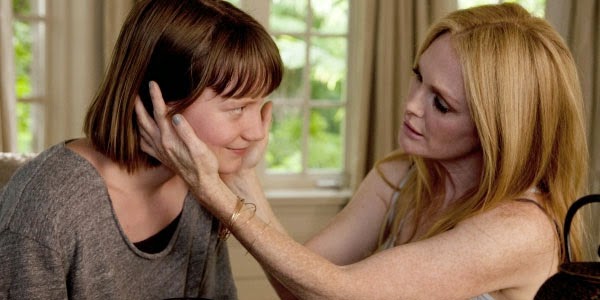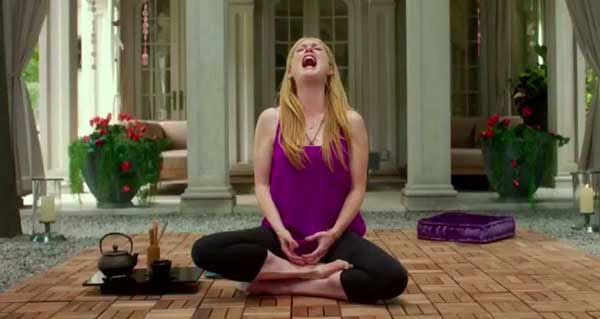David Cronenberg is a profoundly talented filmmaker, and he’s never made a normal film. But originality isn’t itself a good, and as gifted as Cronenberg may be, his ability to heighten the natural language of cinema—to create movies saturated with intrigue and weirdness—can work both ways. When he starts with a strong premise and an intelligent screenplay, he can make operatic marvels like The Fly, A History of Violence, and Eastern Promises. But give him a leaky script and false characters, and his instinctive intensity will only magnify the material’s flaws, resulting in stultifying dreck like Crash, Spider, or Cosmopolis. It’s this innate capacity for augmentation—for blowing up a picture to gargantuan size—that makes Cronenberg perhaps the worst possible choice to make Maps to the Stars, a half-baked Hollywood satire that gradually morphs into a tacky horror movie. With a less capable director, Maps to the Stars would have been little more than a harmless bore. Under Cronenberg’s lurid stewardship, it’s a fascinating atrocity.
The movie begins as a disorienting blur, introducing us to its major players and forcing us to discern their connections ourselves. We meet Agatha (Mia Wasikowska), a burn victim clad in a black dress and matching elbow-length gloves, who arrives in Los Angeles and immediately hires a chauffeur, Jerome (Robert Pattinson, who headlined Cosmopolis), to whisk her to the homes of various celebrities. Then, we’re suddenly inside one of those homes, where 13-year-old Benjie (The Killing‘s Evan Bird), a Justin Bieber-like child star, speaks lewdly with his mother, Christina (Olivia Williams). His father, Stafford (John Cusack), appears briefly and babbles about Tibet, then disappears to engage in a bizarre training session—an apparent combination of massage and hypnotherapy—with Havana (Julianne Moore), a hysterical actress with severe mommy issues.
It’s a bit confusing at first, but even if the logistical connections between these characters aren’t readily apparent, they clearly occupy the same metaphorical space. That’s initially evident in their toxic entitlement and derision, whether it’s Havana attending a lavish party and gossiping with a producer about just how an actress lands all her roles (it involves a sex act that would make even the hardiest pornographer blanch), or Benjie bickering with his producers over the details of his latest lazy sequel. At this point, Maps to the Stars feels like a thin rip-off of The Player, Robert Altman’s legendary inside-baseball look at Hollywood’s soulless machinery. There’s lots of cute name-dropping—when Christina casually compares Benjie’s substance-abuse troubles with those of “Drew”, you’re expected to know that she’s talking about a young Drew Barrymore—that’s supposed to make the movie feel plugged-in, but it comes off as petty, as though the film is anxious to prove its knowhow while simultaneously skewering the industry.
But even if Bruce Wagner’s script seeks to pepper the stale target of celebrity vanity with body blows, Cronenberg seems minimally invested in Maps to the Stars‘ shrill satire. He’s really making a creepy mood piece, which is why his characters share other, stranger similarities. For example, both Benjie and Havana are plagued by visions of dead people: Benjie of a lymphoma patient he dutifully visited in the hospital, and Havana of her mother, Clarice (Cronenberg regular Sarah Gadon), whom she remembers not as an adult but as a teenage sex kitten from her role in an exploitative black-and-white cult classic called Stolen Waters. Clarice mysteriously died in a fire, thus linking her with Agatha, whom we eventually learn is Benjie’s sister and who suffered her scars when she attempted to burn herself and her young brother alive years ago. And Agatha and Benjie are both fond of randomly quoting snippets from “Liberty”, a poem by Paul Eluard. (Paul Thomas Anderson is also name-checked, suggesting that “Liberty” is this movie’s “Wise Up”.)
This is all very silly, and it’s hardly meant to be taken seriously. But while Cronenberg seeks to let us in on the joke, it’s difficult to determine what that joke is, beyond the facile observation that celebrities have their own social codes and twisted values. This mostly manifests in revolting behavior. After Havana hires Agatha as her personal assistant, she learns that Agatha is sleeping with Jerome (he’s a wannabe actor too, of course), and so she swiftly seduces him herself. And when she learns that a rival actress’ young son has died (thereby allowing her to usurp a long-coveted part), she responds by feigning grief, then immediately bursting into a rendition of “Na Na Hey Hey Kiss Him Goodbye”. For his part, Benjie gets high on GHB and inadvertently shoots and kills a friend’s dog.
How awful! How incorrigible! I suppose. But as outrageous as various events in Maps to the Stars may be, they rarely possess any impact beyond bland shock value. That’s partly because, as talented as his cast is, Cronenberg requires them to deliver dual performances, both buying into his self-aware schlock while also standing above it. It’s a virtually impossible task, and the only one who pulls it off is Wasikowska, who somehow invests Agatha with the desired combination of artificiality and grace. The rest veer too strongly in one direction or the other, favoring either cartoonish flamboyance (as is the case with Moore) or numb literalism (as goes for Cusack and Pattinson). (Bird, frankly, is just bad.)
Because Maps to the Stars is a David Cronenberg movie, there is plenty of impressive craft on display. In addition to Peter Suschitzky’s sleek cinematography and Howard Shore’s appropriately ominous score, Cronenberg supplies a number of striking images: a figure on fire glimpsed through glass; ghostly children diving into a pool and disappearing; those black-and-white glimpses of Stolen Waters that ooze with repressed sexuality. Yet the fullness of these images only underscores the utter banality at the film’s core. Cronenberg can dress up anything to look sexy or menacing (or, preferably in his case, both), but even he can’t disguise a narrative of such relentless stupidity.
As Maps to the Stars slides into its ludicrous final act, Agatha, a paranoid schizophrenic, ditches her meds and assumes her rightful role as crazed killer. The instrument of her mayhem: the statuette for a Golden Globe. As that bronzed trophy runs slick with blood, you can hear Cronenberg chortling to himself. But even if you can’t sympathize with Agatha’s victim—possibly because, thanks to Wasikowska, Agatha is the only character in the film who is remotely sympathetic—you can nevertheless feel her pain, the sense of being bludgeoned over and over by a towering figure who has absolutely nothing to say.
Jeremy Beck is the editor-in-chief of MovieManifesto. He watches more movies and television than he probably should.


